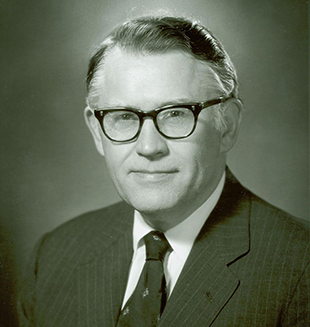

H. Guyford Stever (1916-2010)
“Science and technology have to prove their worth to public and government leaders.
People are not anti-science, but they are asking lots more questions about it.”
–H. Guyford Stever
National Medal of Science in recipient 1991 “for his scientific and engineering leadership in applying new results of scientific research and technological development to the purposes of government, industry and academe.”
H. Guyford Stever was born in Corning, N.Y., where he was raised by his grandmother after his parents died of tuberculosis. As a high-school student during the Depression, Stever enjoyed conducting science experiments in school and with his scout troop, and was fascinated by the pouring of the mirror for the 200-inch telescope at nearby Corning Glass Works.
Stever received a scholarship to Colgate University, where he impressed the science faculty with his knowledge of the telescope. He received a bachelor’s degree in physics and went on to pursue a Ph.D. from the California Institute of Technology. His work on radiation drew attention from prominent members of the field, including Robert Oppenheimer.
While Stever was at Caltech, the Massachusetts Institute of Technology (MIT) established the Radiation Laboratory (Rad Lab), where engineers and scientists collaborated with government and industry to develop radar for use in World War II. After earning his Ph.D. in 1941, Stever joined the faculty at Rad Lab, but shortly after, he was sent to London to assist the military in evaluating German radar technology.
During a visit to Normandy, Stever and several other scientists were captured by Germans, but the Germans acknowledged that they were behind Allied lines and surrendered. Stever returned to MIT after the war and remained at Rad Lab until 1957. He later served for seven years as president of Carnegie Mellon University.
Stever’s early experience working with the military set him up to act as a frequent liaison between the government and the scientific community. He was named chief scientist at the Air Force in 1957 and several months later, was asked to chair a space technology panel that was developed in response to the Russian’s launching of Sputnik. The panel, eventually known as the Stever Committee, was instrumental in the formation of NASA.
Three decades later, he was called upon to oversee the booster rocket redesign following the Challenger explosion. Stever was a science advisor to Presidents Richard M. Nixon and Gerald R. Ford, and served as director of the National Science Foundation (NSF), where he strengthened NSF’s role as a supporter of basic research.
In 1976, the journal The Sciences called Stever “the conscientious shepherd of the American scientific community during a time when zealots in and out of the community have been afire with wildly conflicting schemes concerning the scope, role and responsibilities of science.” From 1982 to 2006, he sat on the board of trustees of Science Service, now known as the Society for Science & the Public.
Stever, who passed away in 2010, had four children with his wife of 60 years, Louise Risley Stever, who died in 2004. The Vannevar Bush Award, which Stever received in 1997, described him as “a voice of reason, wisdom and insight--our sage of science.”
Image descriptions and credits
Any opinions, findings, conclusions or recommendations presented in this material are only those of the presenter grantee/researcher, author, or
agency employee; and do not necessarily reflect the views of the National Science Foundation.


